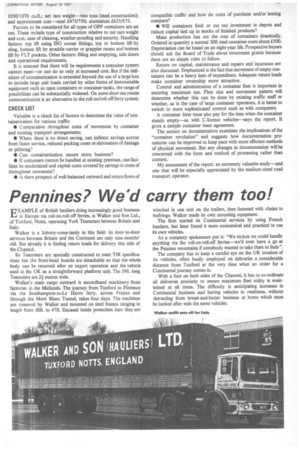The 'nuts and bolts' of containers
Page 86

Page 87

If you've noticed an error in this article please click here to report it so we can fix it.
The National Joint Council on Materials Handling Report on Containerization meets the need for a simple outline of freight container systems.
announced in COMMERCIAL MOTOR last week, the National
Joint Council on Materials Handling has published its Report on Containerization. The study group that compiled it was set up because of the exceptional container traffic growth forecast for the next two years, says study group chairman Mr. W. A. Galbraith in a foreword.
The group found that many organizations were investigating containerization but that their results would not be available for some time. In an urgent "gap-bridging" attempt, the group produced this report.
Mr. Galbraith claims that the report answers many of the detailed questions which did not come within the scope of the British Transport Docks Board report, which concentrated on the economic aspects of containerization.
True: the NJC group looks at the "nuts and bolts" of containers; factors affecting present or potential users. It stresses savings possible from lower packing costs, lower freight charges, quicker delivery and savings in capital tied up in distribution. Also cut: local warehousing facilities.
Pointing to one forecast of a 40-fold increase in container traffic by the early 1970s, Mr. Galbraith maintains that no organization can afford to ignore the container potential for distribution, whether in bulk or otherwise.
The 75-page NJC report is liberally illustrated with sketches, discusses design, use, availability, the economics of owning and leasing, handling, filling and emptying, packaging and documentation. It surveys published materials, and gives a glossary of container terms. Refrigerated, bulk and specialized containers are not considered in detail but are held to be subject to the basic principles which the report outlines.
The report records that the first design consideration of the International Standards Organization was sea freight. Its recommendations were incorporated in British Standard 3951. But a revised ISO recommendation being considered internationally incorporates modifications to dimensions and corner fittings. Optional is the inclusion of bottom pick-up facilities as required by handling equipment such as straddle carriers and grapplers and forktruck pockets. If approved, the recommendations will probably be incorporated in a revised BS 3951.
The study group agrees that bottom pick-up facilities are of prime importance for domestic handling. Forms of top and bottom pick-up are shown.
Report on Containerization gets down to basics. Taking as a random example the 20ft. GPF container, it gives a type description —BS 3951 type B (ISO draft recommendation TC 104 type IC); external and internal dimensions; approximate capacities— 1050/1070 cu.ft.; net tare weight—two tons (steel construction); and approximate cost—steel L475/750; aluminium f625/675.
Factors to be considered for all types of GPF containers are set out. These include type of construction relative to net tare weight and cost, ease of cleaning, weather-proofing and security. Handling factors: top lift using ISO corner fittings, top or bottom lift by sling, bottom lift by straddle carrier or grappler recess and bottom lift by FLT pockets. Other factors: filling and emptying, side doors and operational requirements.
It is stressed that there will be requirements a container system cannot meet—or can do so only at increased cost. But if the definition of containerization is extended beyond the use of a large box to include large unit loads carried by other forms of demountable equipment such as open containers or container-tanks, the range of possibilities can be substantially widened. On some short sea routes containerization is an alternative to the roll-on/roll-off ferry system.
CHECK LIST Valuable is a check list of factors to determine the value of containerization for various traffic: • Comparative throughout costs of movement by container and existing transport arrangements; • Where there is no direct saving, can indirect savings accrue from faster service, reduced packing costs or elimination of damage or pilfering?
• Can containerization secure extra business?
• If containers cannot be handled at existing premises, can facilities be modernized and capital costs covered by savings in costs of throughout movement?
• Is there prospect of well-balanced outward and return flows of compatible traffic and how do costs of purchase and/or leasing compare?
• Will containers limit or cut out investment in depots and reduce capital tied up in stocks of finished products?
Mass production has cut the cost of containers drastically. Ordered in quantity a normal 20ft steel container costs about £300. Depreciation can be based on an eight-year life. Prospective buyers should ask the Board of Trade about investment grants because there are no simple rules to follow.
Return on capital, maintenance and repairs and insurance are also discussed. Emphasized is the fact that movement of empty containers can be a heavy item of expenditure. Adequate return loads make container ownership more attractive.
Control and administration of a container fleet is important in ensuring maximum use. Fleet size and movement pattern will determine whether this can be done by existing traffic staff or whether, as in the case of large container operators, it is better to switch to more sophisticated control such as with computers.
A container hirer must also pay for the time when the container stands empty—as with C-licence vehicles—says the report. It gives a sample container lease agreement.
The section on documentation examines the implications of the "container revolution" and suggests how documentation procedures can be improved to keep pace with more efficient methods of physical movement. But any changes in documentation will be concerned with the form and method of processing rather than content.
My assessment of the report: an extremely valuable study—and one that will be especially appreciated by the medium-sized road transport operator.




































































































































